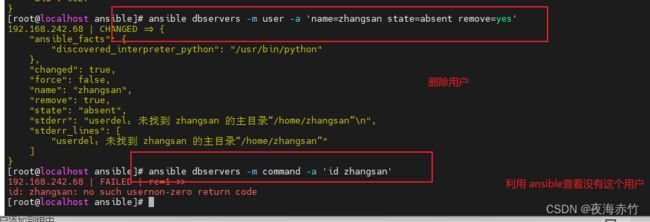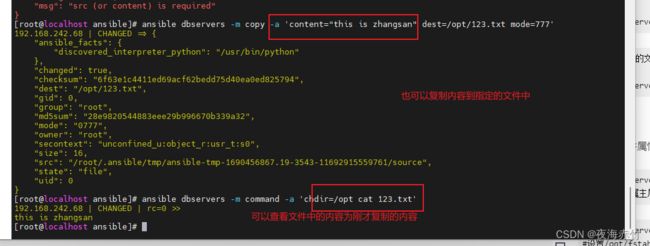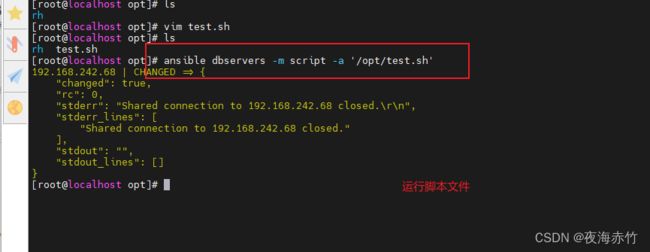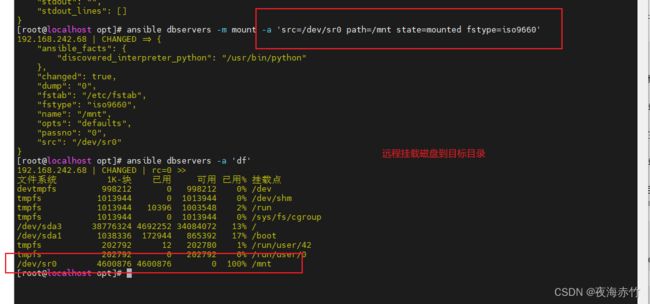1.Ansible
文章目录
- Ansible
-
- 概念
-
- 作用
- 特性
- 总结
- 部署Ansible
- Ansible模块
-
- command
- shell
- cron
- user
- group
- copy
- file
- hostname
- ping
- yum
- serice/systemd
- script
- mount
- archive
- unarchive
- replace
- setup
- inventory主机清单
-
- 主机变量
- 组变量
- 组嵌套
Ansible
概念
- Ansible是一个基于Python开发的配置管理和应用部署工具,现在也在自动化管理领域大放异彩。
- 它融合了众多老牌运维工具的优点,Pubbet和Saltstack能实现的功能,Ansible基本上都可以实现
| 工具 | 语言 | 架构 | 协议 |
|---|---|---|---|
| Puppet | Ruby | C/S | HTTP |
| Chef | Ruby | C/S | HTTP |
| Ansible | Python | 无Client | SSH |
| Saltstack | Python | C/S(可无Client) | SSH/ZMQ/RAET |
作用
- Ansible能批量配置、部署、管理上千台主机。
- 比如以前需要切换到每个主机上执行的一或多个操作,使用Ansible只需在固定的一台Ansible控制节点上去完成所有主机的操作
- Ansible是基于模块工作的,它只是提供了一种运行框架,它本身没有完成任务的能力,真正执行操作的是Ansible的模块, 比如copy模块用于拷贝文件到远程主机上,service模块用于管理服务的启动、停止、重启等
特性
- Ansible其中一个比较鲜明的特性是Agentless,即无Agent的存在,它就像普通命令一样,并非C/S软件,也只需在某个作为控制节点的主机上安装一次Ansible即可,通常它基于ssh连接来控制远程主机,远程主机上不需要安装Ansible或其它额外的服务。
- 使用者在使用时,在服务器终端输入命令或者playbooks,会通过预定好的规则将playbook拆解为play,再组织成ansible可以识别的任务,调用模块和插件,根据主机清单通过SSH将临时文件发给远程的客户端执行并返回结果,执行结束后自动删除
- Ansible的另一个比较鲜明的特性是它的绝大多数模块都具备幂等性(idempotence)。
- 所谓幂等性,指的是无论执行多少次同样的运算,结果都是相同的,即一条命令,任意多次执行所产生的影响均与一次执行的影响相同。
- 比如执行 systemctl stop xxx 命令来停止服务,当发现要停止的目标服务已经处于停止状态,它什么也不会做, 所以多次停止的结果仍然是停止,不会改变结果,它是幂等的,而 systemctl restart xxx 是非幂等的。
- Ansible的很多模块在执行时都会先判断目标节点是否要执行任务,所以,可以放心大胆地让Ansible去执行任务,重复执行某个任务绝大多数时候不会产生任何副作用
总结
- ansible 自动化运维工具(机器管理工具),可以实现批量管理多台 (成百上千) 主机,应用级别的跨主机编排工具
- 特性
- 无agent的存在,不需要在被控制的节点上安装客户端应用
- 通过ssh协议与被控制节点通信
- 基于模块工作的,可以通过模块实现在被控制节点上执行命令操作
- 很多模块具有幂等性,可以实现多次模块操作的状态如果没有发送改变,则不会重复执行
部署Ansible
###安装ansible
yum install -y epel-release
//先安装 epel 源
yum install -y ansible
vim /etc/ansible/hosts
[webservers]
192.168.242.67
[dbservers]
192.168.242.68
###ssh配置
ssh-keygen -t rsa
##查看密钥是否生成
ls /root/.ssh
##修改配置文件
vim /etc/ssh/ssh_config
---35行---
StrictHostKeyChecking no
##连接其他客户端
sshpass -p '123' ssh-copy-id [email protected]
sshpass -p '123' ssh-copy-id [email protected]
Ansible模块
命令格式:ansible <组名> -m <模块> -a <参数列表>
ansible-doc -l
#列出所有已安装的模块,按q退出
ansible-doc -l | wc -l
command
- 在远程主机执行命令,不支持管道,重定向等shell的特性。
- ansible默认模块
ansible-doc -s command
#-s 列出指定模块的描述信息和操作动作
ansible 192.168.242.11 -m command -a 'date'
#指定 ip 执行 date
ansible webservers -m command -a 'date'
#指定组执行 date
ansible dbservers -m command -a 'date'
ansible all -m command -a 'date' #all 代表所有 hosts 主机
ansible all -a 'ls /'
#如省略 -m 模块,则默认运行 command 模块
常用的参数:
chdir:在远程主机上运行命令前提前进入目录
creates:判断指定文件是否存在,如果存在,不执行后面的操作
removes:判断指定文件是否存在,如果存在,执行后面的操作
##确认远程
ansible all -m command -a "chdir=/home ls ./"
##判断文件是否存在,然后执行后面的操作
ansible dbservers -m command -a "chdir=/opt removes=123.txt touch 456.txt"
##command模块测试重定向
ansible dbservers -m command -a 'chdir=/opt echo 789 > 789.txt'
shell
- 在远程主机执行命令,相当于调用远程主机的shell进程,然后在该shell下打开一个子shell运行命令(支持管道符号等功能)
##利用shell模块,测试管道符的作用
ansible dbservers -m shell -a 'echo $(ifconfig ens32 | awk "NR==2 {print \$2}")'
cron
- 在远程主机定义任务计划。
- 其中有两种状态(state):present表示添加(可以省略),absent表示移除
常用的参数:
minute/hour/day/month/weekday:分/时/日/月/周
job:任务计划要执行的命令
name:任务计划的名称
user:指定计划任务属于哪个用户,默认是root用户
##设置自动化任务
ansible dbservers -m cron -a 'weekday="1-5" hour="8,20" minute="30" job="/usr/bin/echo helloworld" name="ggl"'
###在主机中查看计划任务
crontab -e
crontab -l
##删除计划性任务
ansible dbservers -m cron -a 'name="ggl" state=absent'
user
- 用户管理的模块
##常用的参数:
name:用户名,必选参数
state=present|absent:创建账号或者删除账号,present表示创建,absent表示删除
system=yes|no:是否为系统账号
uid:用户uid
group:用户基本组
groups: 用户所属附加组
shell:默认使用的shell
create_home=yse|no: 是否创建家目录
password:用户的密码,建议使用加密后的字符串
remove=yes|no:当state=absent时,是否删除用户的家目录
##创建用户
ansible dbservers -m user -a 'name=zhangsan uid=9527 groups=root shell=/sbin/nologin create_home=no'
ansible dbservers -m shell -a 'echo 123 | passwd --stdin zhangsan'
##删除账号用户,并删除用户的家目录
ansible dbservers -m user -a 'name=zhangsan state=absent remove=yes'
group
- 用户组管理的模块
##创建组
ansible dbservers -m group -a 'name=mysql gid=306 system=yes'
#创建mysql组
##将用户添加到组中
ansible dbservers -m user -a 'name=test01 uid=306 system=yes group=mysql'
#将test01用户添加到mysql组中
copy
- 用于复制指定主机文件到远程主机的
##常用的参数:
dest:指出复制文件的目标及位置,使用绝对路径,如果源是目录,指目标也要是目录,如果目标文件已经存在会覆盖原有的内容
src:指出源文件的路径,可以使用相对路径或绝对路径,支持直接指定目录,如果源是目录则目标也要是目录
mode:指出复制时,目标文件的权限
owner:指出复制时,目标文件的属主
group:指出复制时,目标文件的属组
content:指出复制到目标主机上的内容,不能与src一起使用
##复制文件到目标目录
ansible dbservers -m copy -a 'src=/etc/passwd dest=/opt/passwd owner=test group=mysql mode=666'
##复制内容到文件中
ansible dbservers -m copy -a 'content="this is zhangsan" dest=/opt/123.txt mode=777'
##复制目录中的文件到目标位置
ansible dbservers -m copy -a 'src=/etc/yum.repos.d/ dest=/opt/repo/'
file
- 设置文件属性
ansible dbservers -m file -a 'owner=test01 group=mysql mode=644 path=/opt/123.txt'
#修改文件的属主属组权限等
ansible dbservers -m file -a 'path=/opt/123.link src=/opt/123.txt state=link'
#设置/opt/fstab.link为/opt/fstab.bak的链接文件
ansible dbservers -m file -a "path=/opt/abc.txt state=touch
#创建一个文件
ansible dbservers -m file -a "path=/opt/abc.txt state=absent"
#删除一个文件
hostname
- 用于管理远程主机上的主机名
ansible dbservers -m hostname -a "name=mysql01"
ping
- 检测远程主机的连通性
ansible all -m ping
yum
- 在远程主机上安装与卸载软件包
ansible webservers -m yum -a 'name=httpd' #安装服务
ansible webservers -m yum -a 'name=httpd state=absent' #卸载服务
serice/systemd
- 用于管理远程主机上的管理服务的运行状态
##常用的参数:
name:被管理的服务名称
state=started|stopped|restarted:动作包含启动关闭或者重启
enabled=yes|no:表示是否设置该服务开机自启
runlevel:如果设定了enabled开机自启去,则要定义在哪些运行目标下自启动
ansible webservers -a 'systemctl status httpd'
#查看web服务器httpd运行状态
ansible webservers -m service -a 'enabled=true name=httpd state=started'
#启动httpd服务
script
- 实现远程批量运行本地的 shell 脚本
#!/bin/bash
IPADDR=$(ifconfig ens32 | awk 'NR==2 {print $2}')
echo $IPADDR > /opt/ipaddr.txt
##运行脚本文件
ansible dbservers -m script -a '/opt/test.sh'
mount
- 挂载文件系统
##常用的参数:
src:定义挂载设备的路径
path:定义挂载到哪个目录,必须指定
fstype:指定挂载文件的系统类型,必须指定,xfs、iso9660、nfs...
opts:定义挂载的参数,defaults、rw、ro...
state:定义挂载的状态,mounted(进行挂载,修改/etc/fstab信息)、absent(永久性卸载,并修改 /etc/fstab信息)、unmounted(临时卸载,不修改/etc/fstab信息)
##挂载磁盘
ansible dbservers -m mount -a 'src=/dev/sr0 path=/mnt state=mounted fstype=iso9660'
##解挂磁盘
ansible dbservers -m mount -a 'path=/mnt state=absent'
archive
- 打包压缩
##常用的参数:
path: 必须参数,远程主机上需要被打包压缩的源文件/目录
dest: 打包压缩后的包文件路径(包文件的父目录必须存在);如果包文件已存在,则会被覆盖
format: 指定压缩类型,包括: bz2、gz(默认)、tar、xz、zip
remove=yes|no: 是否删除源文件
##压缩文件
ansible dbservers -m archive -a 'path=/opt/123.txt dest=/opt/123.zip format=zip remove=yes'
unarchive
- 解包解压缩
##常用的参数:
copy:默认为 copy=yes ,拷贝的文件从 ansible 主机复制到远程主机,copy=no 表示在远程主机上寻找源文件解压
src:tar包源路径,可以是 ansible 主机上的路径,也可以是远程主机上的路径,如果是远程主机上的路径,则需设置 copy=no
dest:解压后文件的目标绝对路径
remote_src: 和 copy 功能一样且互斥,设置 remote_src=yes 表示文件在远程主机上,设置为 remote_src=no 表示文件在 ansible 主机上
##将ansible主机的压缩文件拷贝到远程主机进行解压
ansible dbservers -m unarchive -a 'src=/opt/abc.tar.gz dest=/opt/ copy=yes'
###在远程主机上查找压缩包进行解压
ansible dbservers -m unarchive -a 'src=/opt/123.zip dest=/opt/ remote_src=yes'
replace
- 类似于sed命令,主要也是基于正则进行匹配和替换
- 在远程主机修改文件内容
常用的参数:
path:必须参数,指定要修改的文件
regexp:必须参数,指定一个正则表达式
replace:替换regexp参数匹配到的字符串
backup=yes|no: 修改源文件前创建一个包含时间戳信息的备份文件
before:如果指定,则仅替换/删除此匹配之前的内容,可以和after参数结合使用
after:如果指定,则仅替换/删除此匹配之后的内容,可以和before参数结合使用
owner:修改文件用户名
group:修改文件组名
mode:修改文件权限
vim /opt/test.txt
11 22 33 44 55 66
aa bb cc dd ee ff
1a 2b 3c 4d 5e 6f
##匹配 333 并修改为 ccc
ansible dbservers -m replace -a "path=/opt/test.txt regexp='33' replace='cc'"
##匹配到任意一个或多个开头的行增加注释
ansible dbservers -m replace -a "path=/opt/test.txt regexp='^(.*)' replace='#\1'"
##取消a开头的行注释
ansible dbservers -m replace -a "path=/opt/test.txt regexp='^#(a.*)' replace='\1'"
##在cc前面的自读,替换4为three
ansible dbservers -m replace -a "path=/opt/test.txt regexp='4' replace='three' before=cc"
setup
- facts 组件是用来收集被管理节点信息的,使用 setup 模块可以获取这些信息
- 获取远程主机的facts信息
##获取mysql组主机的facts信息(json格式)
ansible dbservers -m setup
##使用filter可以筛选指定的facts信息
ansible dbservers -m setup -a 'filter=*ipv4'
inventory主机清单
- Inventory支持对主机进行分组,每个组内可以定义多个主机,每个主机都可以定义在任何一个或多个主机组内
###如果是名称类似的主机,可以使用列表的方式标识各个主机。
vim /etc/ansible/hosts
[webservers]
192.168.242.67:2222
#冒号后定义远程连接端口,默认是 ssh 的 22 端口
192.168.242.1[2:5]
#表示从 192.168.242.12到192.168.242.15
或者
[a:z].ggl.com
[dbservers]
db-[a:f].example.org #支持匹配 a~f
| inventory中的变量名 | 含义 |
|---|---|
| ansible_host | ansible连接节点时的IP地址 |
| ansible_port | 连接对方的端口号,ssh连接时默认为22 |
| ansible_user | 连接对方主机时使用的用户名。不指定时,将使用执行ansible或ansible-playbook命令的用户 |
| ansible_password | 连接时的用户的ssh密码,仅在未使用密钥对验证的情况下有效 |
| ansible_ssh_private_key_file | 指定密钥认证ssh连接时的私钥文件 |
| ansible_ssh_common_args | 提供给ssh、sftp、scp命令的额外参数 |
| ansible_become | 允许进行权限提升 |
| ansible_become_method | 指定提升权限的方式,例如可使用sudo/su/runas等方式 |
| ansible_become_user | 提升为哪个用户的权限,默认提升为root |
| ansible_become_password | 提升为指定用户权限时的密码 |
主机变量
192.168.242.6[6:9] ansible_user=root ansible_password=123
###在没有设置ssh密钥时,可以使用账号密码来登陆
192.168.242.69 ansible_user=root ansible_password=123 ansible_port=2233
##也能够指定ssh访问的端口号
组变量
##表示为 webservers 组内所有主机定义变量
[webservers:vars]
ansible_user=root
ansible_password=123
组嵌套
##表示为 webs 主机组中包含了 nginx 组和 apache 组内的所有主机
[webs:children]
nginx
apache
[nginx]
192.168.242.67
[apache]
192.168.242.68
























































